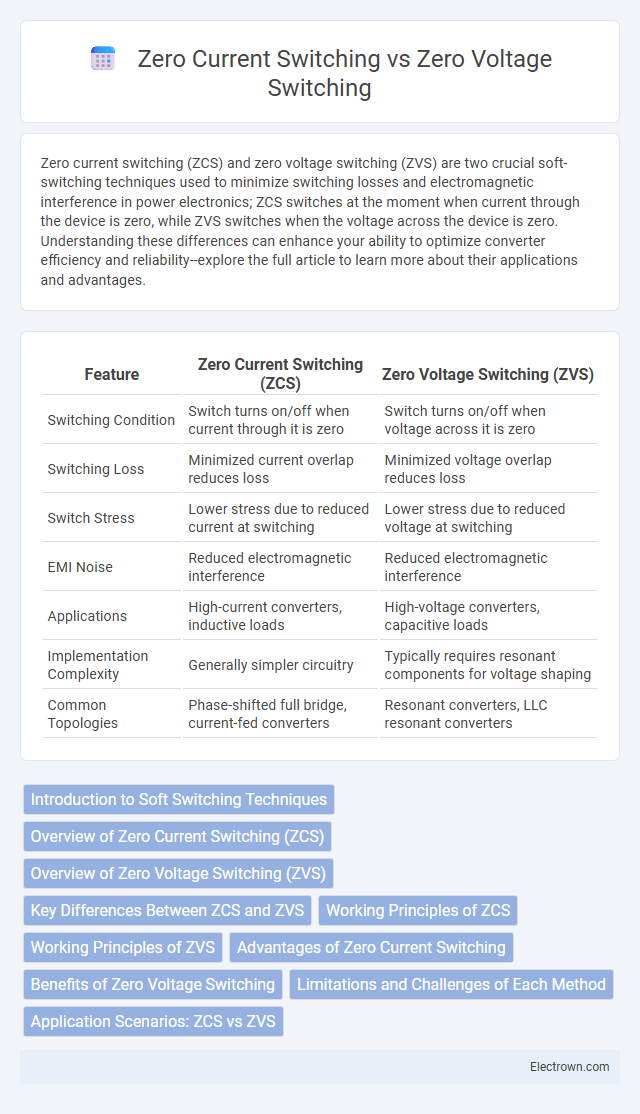Zero current switching (ZCS) and zero voltage switching (ZVS) are two crucial soft-switching techniques used to minimize switching losses and electromagnetic interference in power electronics; ZCS switches at the moment when current through the device is zero, while ZVS switches when the voltage across the device is zero. Understanding these differences can enhance your ability to optimize converter efficiency and reliability--explore the full article to learn more about their applications and advantages.
Table of Comparison
| Feature | Zero Current Switching (ZCS) | Zero Voltage Switching (ZVS) |
|---|---|---|
| Switching Condition | Switch turns on/off when current through it is zero | Switch turns on/off when voltage across it is zero |
| Switching Loss | Minimized current overlap reduces loss | Minimized voltage overlap reduces loss |
| Switch Stress | Lower stress due to reduced current at switching | Lower stress due to reduced voltage at switching |
| EMI Noise | Reduced electromagnetic interference | Reduced electromagnetic interference |
| Applications | High-current converters, inductive loads | High-voltage converters, capacitive loads |
| Implementation Complexity | Generally simpler circuitry | Typically requires resonant components for voltage shaping |
| Common Topologies | Phase-shifted full bridge, current-fed converters | Resonant converters, LLC resonant converters |
Introduction to Soft Switching Techniques
Soft switching techniques minimize switching losses and electromagnetic interference in power electronic devices by controlling voltage and current waveforms during transitions. Zero current switching (ZCS) achieves this by turning the switch on or off when the current through it is zero, reducing switching stress and heat dissipation. Zero voltage switching (ZVS) instead switches when the voltage across the device is zero, optimizing efficiency and improving reliability in high-frequency converters, making your power systems more energy-efficient and durable.
Overview of Zero Current Switching (ZCS)
Zero Current Switching (ZCS) minimizes switching losses and electromagnetic interference by turning off the switch when the load current reaches zero, improving efficiency in power converters. This technique reduces stress on semiconductor devices, extending their lifespan and enhancing overall system reliability. Understanding ZCS helps you optimize your power electronics for high-performance and low-loss operation.
Overview of Zero Voltage Switching (ZVS)
Zero Voltage Switching (ZVS) is a power electronics technique that minimizes switching losses by turning on the transistor when the voltage across it is zero, reducing stress and electromagnetic interference. Compared to Zero Current Switching (ZCS), ZVS focuses on voltage control, enabling higher frequency operation and improved efficiency in converters like resonant and soft-switching topologies. Understanding ZVS can optimize your power system design by enhancing reliability and thermal performance.
Key Differences Between ZCS and ZVS
Zero Current Switching (ZCS) minimizes switching losses by turning devices on or off when the current is zero, reducing stress and electromagnetic interference. Zero Voltage Switching (ZVS) achieves similar benefits by switching when the voltage across the device is zero, enhancing efficiency in high-frequency applications. Your choice depends on the specific circuit requirements, as ZCS is preferred for current-driven devices while ZVS suits voltage-driven devices better.
Working Principles of ZCS
Zero Current Switching (ZCS) operates by turning on or off the power switch precisely when the current through the device is zero, minimizing switching losses and electromagnetic interference. This method relies on the natural resonance of inductive and capacitive elements in the circuit to ensure current zero-crossing aligns with switching events, enhancing efficiency in power converters. ZCS is especially advantageous in high-current, low-voltage applications where reducing current stress on semiconductor devices is critical for reliability.
Working Principles of ZVS
Zero Voltage Switching (ZVS) operates by turning on the power switch when the voltage across it is near zero, minimizing switching losses and electromagnetic interference. The working principle relies on the resonant or soft-switching circuit to discharge the switch capacitance before conduction, resulting in reduced stress and improved efficiency. Your power electronics system benefits from enhanced reliability and lower thermal dissipation due to this voltage-controlled timing approach.
Advantages of Zero Current Switching
Zero Current Switching (ZCS) minimizes switching losses by turning off the switch when the current through it is zero, which reduces stress and electromagnetic interference in power electronics systems. This technique improves converter efficiency and extends device reliability compared to hard-switching methods. ZCS is especially beneficial in high-current applications where managing switching losses and thermal performance is critical.
Benefits of Zero Voltage Switching
Zero Voltage Switching (ZVS) significantly reduces switching losses and electromagnetic interference by ensuring that the switch transitions occur when the voltage across the switch is nearly zero. This technique enhances the efficiency and reliability of power converters by minimizing stress on semiconductor devices and reducing heat generation. Compared to Zero Current Switching (ZCS), ZVS offers better performance at higher frequencies, enabling more compact and lightweight designs in applications like resonant converters and DC-DC power supplies.
Limitations and Challenges of Each Method
Zero current switching (ZCS) faces limitations such as increased switch voltage stress and potential electromagnetic interference due to rapid voltage transitions. Zero voltage switching (ZVS) challenges include higher current stresses and difficulty maintaining zero voltage conditions under varying load conditions. Both methods require precise timing control to minimize switching losses and device stress, which complicates circuit design and increases control complexity.
Application Scenarios: ZCS vs ZVS
Zero current switching (ZCS) is ideally suited for applications with high inductive loads where minimizing switching loss and electromagnetic interference is critical, such as in motor drives and inductive heating. Zero voltage switching (ZVS) excels in high-frequency power conversion scenarios like resonant converters and DC-DC converters, where reducing voltage stress on the semiconductor devices enhances efficiency and prolongs component life. Your choice between ZCS and ZVS depends on the specific load characteristics and switching frequency requirements of your power electronics system.
Zero current switching vs Zero voltage switching Infographic

 electrown.com
electrown.com